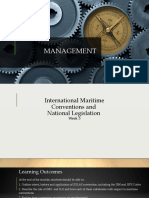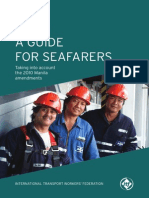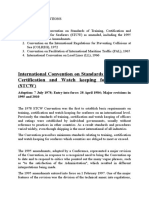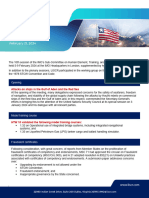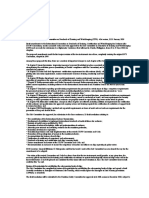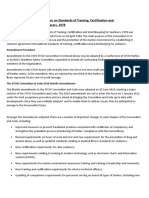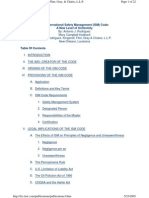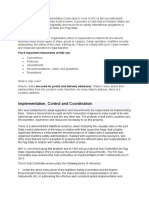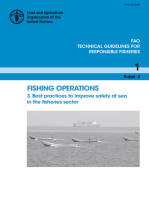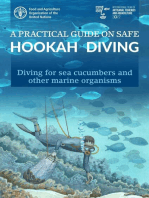Focus On Imo
Focus On Imo
Uploaded by
Leo ThomasCopyright:
Available Formats
Focus On Imo
Focus On Imo
Uploaded by
Leo ThomasOriginal Title
Copyright
Available Formats
Share this document
Did you find this document useful?
Is this content inappropriate?
Copyright:
Available Formats
Focus On Imo
Focus On Imo
Uploaded by
Leo ThomasCopyright:
Available Formats
Focus on IMO
International Maritime Organization, 4 Albert Embankment, London SE1 7SR, United Kingdom Tel: +44 (0)20 7735 7611 Fax: +44 (0)20 7587 3210 E-mail: rkohn@imo.org or nbrown@imo.org Web site: www.imo.org
March 1997
The new STCW Convention
The 1995 amendments to the International Convention on Standards of Training, Certification and Watchkeeping for Seafarers (STCW), 1978
Background Since its inception in 1959 IMO has endeavoured not only to improve the safety of ships and their equipment but also to raise the standards of the seafarers which man them. Among the many resolutions adopted in 1960 at the International Conference on the Safety of Life at Sea was one which called upon Governments to take all practicable steps to ensure that the education and training of seafarers in the use of aids to navigation, ships' equipment and devices was sufficiently comprehensive and was kept satisfactorily up to date. It also recommended that IMO and the International Labour Organisation should co-operate with each other and with interested Governments in achieving these ends. In response to this recommendation, the Governing Body of ILO and IMO's Maritime Safety Committee (MSC) established a Joint Committee on Training. This Committee had its first meeting in 1964 and prepared the Document for Guidance 1964. This Document gave guidance on the education and training of masters, officers and seamen in the use and operation of aids to navigation, life-saving appliances, devices for the prevention, detection and extinction of fires, and other ship's equipment contributing to safety at sea. The Document was subsequently amended, expanded and supplemented by the Joint Committee in 1975, 1977 and 1985. Despite the success of this Document, the IMO Council in 1971 decided that still further measures were needed to strengthen and improve standards and it requested the MSC to give urgent consideration to international standards of watchkeeping, training and certification. The IMO Assembly, which also met in 1971, decided to convene a conference to adopt a convention on the subject. Preparatory work was carried out by the IMO Sub-Committee on Standards of Training and Watchkeeping, which prepared the text of a draft convention, an annex containing requirements for watchkeeping, training and certification and a number of draft recommendations.
The 1978 STCW Convention
The conference met in 1978 and was attended by delegates from 72 countries. It was the largest conference ever held by IMO up to that time and the Convention which resulted was regarded as one of the most important maritime safety conventions ever developed. The Convention was the first attempt to establish global minimum professional standards for seafarers. Previously the standards of training, certification and watchkeeping of officers and ratings were established by individual governments, usually without reference to practices in other countries. As a result standards and procedures varied widely, even though shipping is the most international of all industries. The Convention prescribes minimum standards which countries are obliged to meet or exceed. In the majority of established maritime countries, standards are often higher than those stipulated in the Convention. In some countries, however, standards are not so high and by ratifying or accepting the Convention Governments undertake to implement and enforce its requirements. The effect of the Convention's entry into force was therefore to raise standards in the world as a whole. The Convention does not deal with manning levels: IMO provisions in this area are covered by regulation 13 of chapter V of the International Convention for the Safety of Life at Sea (SOLAS), 1974, whose requirements are backed up by resolution A.481(XII) which was adopted by the IMO Assembly in 1981. The requirement for entry into force of the Convention was the same as for the International Convention for the Safety of Life at Sea: acceptance by 25 countries whose combined fleets of merchant shipping represent at least 50 per cent of world tonnage. This target was reached on 27 April 1983 and the Convention entered into force one year later, on 28 April 1984. The Convention has been accepted by 114 States with fleets aggregating 94.99% of the world merchant shipping tonnage. When the Convention entered into force, it was expected that its requirements would ensure the competence of masters, officers and ratings of all seagoing ships and their safe operation through efficient watchkeeping. As with all IMO Conventions it reflected the highest practicable standards which could be globally agreed at the time of its adoption. But despite its broad global acceptance, it was realized by the late eighties that the Convention was not achieving its purpose. Instead it was gradually losing credibility as its acceptance widened. The main cause for this appeared to be the general lack of precision in its standards, the interpretation of which was left "to the satisfaction of the Administration". This resulted in widely varying interpretation of standards and many Parties failed to effectively administer and enforce Convention requirements. STCW certificates could no longer be relied upon as evidence of competence. Other factors had reduced the effectiveness of the 1978 Convention such as the reliance placed on seafaring skills and competence being acquired through service on board ship or in machine shops. The Convention had prescribed minimum periods of seagoing or other appropriate service and specified knowledge requirements without defining the skills and competence required. Crew reductions, faster turn-rounds, more frequent crew changes and the mix of differing education and training backgrounds resulting from multinational manning, undermined the effectiveness of this on-board training. Since the development of the Convention in the seventies, many changes had taken place in the structure of the world merchant fleet and in the management and manning of ships. Emerging economies had acquired greater maritime expertise and expanded their fleets. The fleets of
traditional maritime countries had declined and the major sources of supply of seafarers had also shifted. In response to these changes IMO technical co-operation projects had strengthened the maritime administrations and maritime education and training capabilities of developing countries, by improving their facilities and equipment and enhancing their expertise by training their administrators and educators at the World Maritime University in Malm, Sweden. The traditional organization of duties and responsibilities on board ship was also changing. Some felt that management response to emerging safety, efficiency and career development needs and expectations had become hampered by the traditional departmental structure upon which the 1978 Convention had been exclusively based. Within the industry, the need for greater flexibility in the training and certification of seafarers became a significant force in the demand for change. The loss of credibility of the Convention and political and public concern regarding human related causes of shipping disasters, generated growing criticism not only of the Convention itself but also of IMO, which some claimed to be ineffective and unresponsive to the safety needs of the travelling public and the protection of the marine environment from accidental pollution. A limited review of Convention provisions was already in hand, when the Maritime Safety Committee decided, in May 1993, to give high priority to its comprehensive review. On the suggestion of Mr. William A. O'Neil, the Secretary-General of IMO, the comprehensive review was accelerated by having consultants prepare a revised text under the direction of the Sub-Committee on Standards of Training and Watchkeeping (STW). The original date for completing the revision at sub-committee level was 1996, meaning that the revision conference would probably not have been held until 1998. Under the accelerated programme the conference was brought forward to June-July 1995. The use of consultants and four sessions of an Inter-Sessional Working Group of the STW Sub-Committee allowed basic texts to be approved by IMO and circulated for the 1995 Diplomatic Conference within a two year period. Although the group of consultants was kept small to allow speedy completion of its work, all regions were represented in its membership. All consultants acted as independent experts and were sponsored by Germany, The Netherlands, Mexico, Korea, Spain, the United Kingdom and the United States. Organizations in consultative status, including the International Shipping Federation and the International Confederation of Free Trade Unions 1 also contributed to the work as did the Arab Maritime Transport Academy, Dalian Maritime University, the National Maritime Academy of Singapore, Singapore Polytechnic and the World Maritime University. The ease of acceptance of the basic text by the Conference in June/July 1995 reflected the quality of the preparatory work.
The ICFTU consultant was sponsored by the International Transportworkers Federation.
The main aims of the revision were: .1 .2 .3 to transfer all detailed technical requirements to an associated Code; to clarify the skills and competence required; to require Administrations to maintain direct control over and endorse the qualifications of those masters, officers and radio personnel they authorize to serve on their ships; to make Parties to the Convention accountable to each other, thr ough IMO, for their proper implementation of the Convention and the quality of their training and certification activities; and to have the amendments enter into force for all Parties to the Convention with the least possible delay.
.5
The 1995 amendments
For procedural reasons, it was decided not to amend the articles of the Convention. This can only be done by the "positive acceptance" procedure, meaning that any amendments adopted would require the acceptance of two-thirds of Parties before entering into force, a process which would have taken many years. By concentrating simply on the technical annex, it was possible to make use of the Convention's "tacit acceptance" provisions, under which amendments adopted by the Conference can enter into force within a minimum of one year (and a maximum of two years) unless they are rejected in the meantime by sufficient Parties 2. The amendments entered into force under this procedure on 1 February 1997. Until 1 February 2002, however, Parties may continue to issue, recognize and endorse certificates which applied before that date in respect of seafarers who began training or seagoing service before 1 August 1998.
The articles
The articles (which, as was explained above were unchanged by the 1995 amendments) contain the legal provisions of the Convention while the technical content is incorporated in the annex. The articles deal with entry into force provisions, amendment procedures, denunciation and various other matters. One especially important feature of the Convention is that it applies to ships of non-party States when visiting ports of States which are Parties to the Convention. Article X requires Parties to apply the control measures to ships of all flags to the extent necessary to ensure that no more favourable treatment is given to ships entitled to fly the flag of a State which is not a Party than is given to ships entitled to fly the flag of a State that is a Party. The difficulties which could arise for ships of States which are not Parties to the Convention is one reason why the Convention has received such wide acceptance. Certificates, each authorizing the holder to serve in a stated capacity, are the basic control provision of the Convention and article VI requires that they be issued only to those who meet the requirements of the Convention. Article X states that ships (with some exceptions, such as warships and fishing vessels) are subject, while in the ports of a Party, to control by officers duly authorized to verify that personnel on board hold the required certificates.
One third of Parties or Parties whose combined merchant fleets constitute not less than 50% of world tonnage.
Deficiencies are required to be reported to the master and to the authorities of the flag State. If the deficiencies are such that they are judged to pose a 'danger to persons, property or the environment, the Party carrying out the control shall take steps to ensure that the ship will not sail unless and until the Convention requirements are met to the extent that the danger has been removed.' Although one aim of the Convention is that in future all certificates shall ultimately be issued in accordance with its requirements, the need for transitional provisions is recognized in article VII. It states that certificates issued before entry into force of the Convention for a Party shall remain valid, no matter what the standards may have been. After the entry into force of the Convention for a Party, its Administration may continue to issue certificates of competence in accordance with its previous practices for a period not exceeding five years. This provision will enable the requirements of certificates to be updated in line with technical and other changes. Article VIII describes how, in circumstances of exceptional necessity, dispensations may be granted to enable seafarers to serve in capacities for which they do not hold appropriate certificates, but no such dispensation is permitted in the case of a radio officer or operator. The Convention also incorporates in article XII a 'tacit acceptance' procedure similar to that included in the 1974 SOLAS Convention. Under this procedure amendments to the STCW Convention or its annex may be adopted by IMO's Maritime Safety Committee, expanded to include all Contracting Parties, some of whom may not be members of the Organization. Amendments to the STCW annex will normally enter into force one and a half years after being communicated to all Parties unless, in the meantime, they are rejected by one-third of the Parties or by Parties whose combined fleets represent 50 per cent of world tonnage. Article XI of the Convention deals with technical co-operation and it requires Parties to promote support for Parties which request technical assistance in such matters as training.
The regulations and the STCW Code
One of the major features of the revision is the adoption of a new STCW Code, to which many technical regulations have been transferred. Part A of the Code is mandatory while Part B is recommended. Dividing the regulations up in this way makes administration easier and it will also make the task of revising and updating them more simple: for procedural and legal reasons there is no need to call a full conference to make changes to Codes. Another important change means that for the first time IMO itself is given some authority over individual Parties. Under Chapter I, regulation I/ 7 Parties will be required to provide detailed information to IMO concerning administrative measures taken to ensure compliance with the Convention, education and training courses, certification procedures and other factors relevant to implementation. This information will be used by the Maritime Safety Committee (MSC), IMO's senior technical body, to identify Parties that are able to demonstrate that they can give full and complete effect to the Convention. This regulation is regarded as particularly important because it means that Governments will have to establish that they have the administrative, training and certification resources necessary to implement the Convention. No such proof was required in the original Convention (or in any other IMO instrument), leading to complaints that standards differed widely from country to country and certificates could therefore not always be relied on. The regulation is backed up by section A-I/7 of the STCW Code which requires the information to be submitted to IMO by 1 August 1998 and says that it must include the following: 1 the name, postal address and telephone and facsimile numbers and organization chart of the ministry, department or governmental agency responsible for administering the Convention;
5
2 a concise explanation of the legal and administrative measures provided and taken to ensure compliance, particularly with regulations I/6 (training and assessment) and I/9 (medical standards and the issue and registration of certificates); 3 a clear statement of the education, training, examination, competency assessment and certification policies adopted; 4 a concise summary of the courses, training programmes, examinations and assessments provided for each certificate issued pursuant to the Convention; 5 a concise outline of the procedures followed to authorize, accredit or approve training and examinations, medical fitness and competency assessments, required by the Convention, the conditions attaching thereto, and a list of the authorizations, accreditations and approvals granted; 6 a concise summary of the procedures followed in granting any dispensation under article VIII of the Convention; and 7 the results of the comparison carried out pursuant to regulation I/11 and a concise outline of the refresher and upgrading training mandated. Section A-I/7 also requires the Secretary-General to maintain a list of competent persons approved by the MSC who may be called upon to assist in the preparation of the report required by regulation I/ 7. Meetings of those on the list may be held at the discretion of the Secretary-General and their views shall be taken into account in the report submitted to the MSC. Regulation I/8 of the Convention requires a quality standards system to be used where training, assessment of competence, certification, endorsement and revalidation activities are carried out. Further provisions covering this point are contained in Section A-I/8 of the Code. Other important amendments to Chapter I (General Provisions) include the following: Enhanced procedures concerning the exercise of port State control under Article X of the Convention have been developed to allow the competence of seafarers in carrying out watchkeeping to be assessed and to permit intervention in the case of deficiencies deemed to pose a danger to persons, property or the environment (regulation I/4). This can take place if certificates are not in order or if the ship is involved in a collision or grounding, if there is an illegal discharge of substances (causing pollution) or if the ship is manoeuvred in an erratic or unsafe manner, etc. Parties are required to establish procedures for investigating acts by persons to whom they have issued certificates that endanger safety or the environment. Penalties and other disciplinary measures must be prescribed and enforced where the Convention is not complied with. Technical innovations, such as the use of simulators for training and assessment purposes have been recognized. Simulators will become mandatory for training in the use of radar and automatic radar plotting aids. Parties will be required to ensure that training, certification and other procedures are continuously monitored by means of a quality assurance system (regulation I/8). Every master, officer and radio operator shall be required at intervals not exceeding five years to meet the fitness standards and the levels of professional competence contained in Section A-I/11 of the STCW Code.
In order to assess the need for revalidation of certificates after 1 February 2002, Parties must compare the standards of competence previously required with those specified in the appropriate certificate in part A of the STCW Code. If necessary, the holders of certificates may be required to undergo training of refresher courses (regulation I/11). Provisions covering the use of simulators, in particular radar and automatic radar plotting aids equipment, are contained in regulation I/12 (and section A-I/12 of the STCW Code).
The remaining chapters are as follows: Chapter II: Master and deck department Chapter III: Engine department Chapter IV: Radiocommunication and radio personnel Chapter V: Special training requirements for personnel on certain types of ships. Special requirements have been introduced concerning the training and qualifications of personnel on board ro-ro passenger ships. Previously the only special requirements in the Convention concerned crews on tankers. This change was made in response to proposals made by the Panel of Experts set up to look into ro-ro safety following the capsize and sinking of the ferry Estonia in September 1994.Crews on ro-ro ferries will have to receive training in technical aspects and also in crowd and crisis management and human behaviour. Chapter VI: Emergency, occupational safety, medical care and survival functions. Chapter VII: Alternative certification. Regulations regarding alternative certification (also known as the functional approach) have been included in a new Chapter VII. This involves enabling crews to gain training and certification in various departments of seafaring rather than being confined to one branch (such as deck or engine room) for their entire career. Although it is a relatively new concept, the Conference was anxious not to prevent its development. At the same time, the new Chapter is intended to ensure that safety and the environment are not threatened in any way. The use of equivalent educational and training arrangements is permitted under article IX. Chapter VIII: Watchkeeping. Measures have been introduced for watchkeeping personnel to prevent fatigue. Administrations are required to establish and enforce rest periods for watchkeeping personnel and to ensure that watch systems are so arranged that the efficiency of watchkeeping personnel is not impaired by fatigue.
The STCW Code
The regulations contained in the Convention are supported by sections in the STCW Code. Generally speaking, the Convention contains basic requirements which are then enlarged upon and explained in the Code. Part A of the Code is mandatory. The minimum standards of competence required for seagoing personnel are given in detail in a series of tables. Chapter II of the Code, for example, deals with standards regarding the master and deck department. An extract is given on the next page. Part B of the Code contains recommended guidance which is intended to help Parties implement the Convention. The measures suggested are not mandatory and the examples given are only intended to illustrate how certain Convention requirements may be complied with. However, the recommendations in general represent an approach that has been harmonized by discussions within IMO and consultation with other international organizations.
Specification of minimum standards of competence for masters and chief mates of ships of 500 tons gross tonnage or more Competence Knowledge, understanding and proficiency Thorough knowledge of content, application and intent of the International Regulations for Preventing Collisions at Sea Through knowledge of the content, application and intent of the Principles to be Observed in Keeping a Navigational Watch. Effective bridge teamwork procedures. Methods for demonstrating competence Examination and assessment of evidence obtained from one or more of the following: 1. Approved in-service experience 2. Approved simulator training, where appropriate. Criteria for evaluating competence Watchkeeping arrangements and procedures are established and maintained in compliance with international regulations and guidelines so as to ensure the safety of navigation, protection of the marine environment and the safety of the ship and persons on board.
Establish watchkeeping arrangements and procedures
Resolutions
It is expected that the need to provide information to IMO and the powers given to the MSC to assess the actions of national Governments will greatly strengthen the effectiveness of the Convention. But it is also recognized that it will be difficult for some Governments to comply with the amendments without assistance. One of the resolutions adopted by the Conference recognizes the importance of education, training and appropriate experience for all seafarers. It also recognizes that "in some cases, there may be limited facilities for obtaining the required experience and providing specialized training programmes, particularly in developing countries." It says that "the promotion of technical co-operation at an inter-governmental level will assist those States not yet having adequate expertise or facilities for providing such training and experience to implement the revised STCW Convention requirements." The resolution "strongly urges Parties to provide, or arrange to provide, in co-operation with IMO, assistance to those States which have difficulty in meeting the improved requirements of the STCW Convention and which request such assistance." Another resolution recognizes the contribution made by the World Maritime University in raising standards and notes that it can help deal with the need for personnel in the international maritime field by "assuming a leading role for the transfer of maritime education and knowledge through its activities and the networking of advanced maritime training establishments." In a further resolution, IMO itself is called upon to revise and update the model training courses that have been developed over the years to provide core curricula for use in maritime academies and similar institutions. Other resolutions adopted by the Conference dealt with: training in crisis management and human behaviour for personnel on board ro-ro passenger ships and training of personnel on passenger ships monitoring the implications of alternative certification
development of international standards of medical fitness for seafarers promotion of the participation of women in the maritime industry.
International Convention on Standards of Training, Certification and Watchkeeping for Fishing Vessel Personnel (STCW-F)
While the amendments to the STCW Convention were being considered, a separate conference running concurrently adopted a new International Convention on Standards of Training, Certification and Watchkeeping for Fishing Vessel Personnel (STCW-F). Because of the nature of the fishing industry it is extremely difficult to develop regulations for other sections of the shipping industry which can be applied without modification to fishing vessels as well. The Convention will apply to crews of seagoing fishing vessels, generally of 24 metres in length and above. The Conference was attended by delegates from 74 countries. It was originally intended that requirements for crews on fishing vessels should be developed as a Protocol to the main STCW Convention, but after careful consideration it was agreed that it would be better to adopt a completely separate Convention. The Convention is the first attempt to make standards of safety for crews of fishing vessels mandatory. The STCW-F Convention is comparatively short and consists of 16 Articles and several chapters contained in an annex. Chapter I contains General Provisions and Chapter II deals with Certification of Skippers, Officers, Engineer Officers and Radio Operators. Previously efforts to improve the training, certification and watchkeeping standards of fishing vessels' personnel have been adopted as recommendations in Assembly resolutions and the Document for Guidance on Fishermens' Training and Certification produced jointly by IMO and the Food and Agriculture Organization (FAO) and the International Labour Organisation (ILO). The Convention will enter into force 12 months after being accepted by 15 States.
The 1978 Convention
Although the 1995 amendments represent a complete re-write of the technical aspects of the STCW Convention, the original 1978 text will continue to apply to many of the world's ships and seafarers until the year 2002.
The Annex
This contains the technical provisions of the Convention. It is divided into six chapters which deal with the following subjects: I. General provisions; II. Master-deck department; III. Engine department; IV. Radio department; V. Special requirements for tankers; VI. Proficiency in survival craft.
Chapter I: General provisions
This starts with a list of definitions of terms used in the annex. Regulation I/2 deals with the content of the certificate and the endorsement form, which is required to be placed on the certificate by article VI. All certificates must include a translation into English, if that is not the official language of the issuing country. In some parts of the annex, relaxations in the requirements are provided for seafarers on ships engaged on near-coastal voyages; that is to say voyages in the vicinity of a Party as defined by that Party.
Principles governing near-coastal voyages are set out in regulation I/3.Regulation 1/4 deals with control procedures and elaborates on article X. Control is limited to checking the certificates of personnel and assessing the ability of seafarers to maintain convention standards in certain eventualities, such as the ship's involvement in a collision or grounding, the discharge of an illegal substance or erratic or unsafe manoeuvring. Failure of seafarers to hold a certificate required by the Convention, to have an appropriate valid certificate or valid dispensation, would, if not corrected, result in the Party carrying out the control having to take steps to ensure that the ship will not sail unless and until these requirements are met to the extent that the danger has been removed. However, certificates must be accepted unless there are clear grounds for believing a certificate has been fraudulently obtained or that the holder is not the person to whom it was issued. The officer carrying out the control is also required to give written notification of the grounds on which it has been determined that any deficiencies found pose a danger to persons, property or the environment. These procedures permits the flag State Administration to take appropriate corrective action through the Party carrying out the control or by sending their own surveyor or representative to the port concerned. If the deficiency, the existence of which has been clearly established by the control officer, is not corrected by the master, owner or Administration concerned, and such deficiency poses a danger to persons, property or the environment, the Party carrying out the control is required to take steps to ensure that the ship will not sail. However, paragraph (4) of article X requires all possible efforts to be made to avoid unduly detaining or delaying the ship. This is a more onerous requirement than having to make all practical efforts or best efforts. A Party exercising control thus has to ensure that all necessary officials are accessible at all times and that all necessary communications can be passed without delay.
Chapter II: Master-deck department
The chapter establishes the basic principles to be observed in keeping a navigational watch, covering such matters as watch arrangements, fitness for duty, navigation, navigational equipment, navigational duties and responsibilities, the duties of the look-out, navigation with a pilot on board ('...his presence on board does not relieve the master or officer in charge of the watch from their duties...'), and protection of the marine environment. Regulation II/2 establishes mandatory minimum requirements for certificating masters and chief mates of ships of 200 gross tons to 1,600 gross tons and for ships of 1,600 gt and more. Candidates must meet the requirements for certification as an officer in charge of a navigational watch on ships of 200 gt or more and have approved sea-going service in that capacity. Candidates must also have passed an appropriate examination covering not only navigational aspects and ship-handling but ship stability, construction and damage control; power plants; cargo handling and stowage; fire prevention; medical care; maritime law (including SOLAS and other IMO conventions); personnel management and training; communications; life-saving; search and rescue; and methods for demonstrating proficiency. The examination may be varied for officers and masters of ships engaged on near-coastal voyages. Regulation II/3 sets out mandatory minimum requirements for certification of officers in charge of a navigational watch and masters of ships of less than 200 gt. For ships of less than 200 gt which are not engaged on near-coastal voyages, appropriate certificates for ships of 200 gt to 1,600 gt must be held (in the case of masters) and above 200 gt in the case of officers.
10
For ships of less than 200 gt engaged on near-coastal voyages, masters must hold an appropriate certificate; be not less than 20 years of age; have approved sea-going service of not less than 12 months as officer in charge of a navigational watch; and satisfy the Administration that they possess adequate knowledge, including knowledge of the subjects listed in an appendix to the regulation. Officers must have an appropriate certificate; be not less than 18 years old; be medically fit; have undergone special training; have completed three years' service in the deck department; and possess adequate knowledge, including knowledge of the subjects listed in an appendix to the regulation. The mandatory minimum requirements for certification of officers in charge of a navigational watch on ships of 200 gt or more are contained in regulation II/4. The age limit is 18 and the three years' sea-going service must include 'at least six months of bridge watchkeeping duties under the supervision of a qualified officer.' Candidates must also pass an examination based upon the subjects listed in an appendix which includes many of the subjects appended to regulation II/2. Among the additional requirements is one for an 'adequate knowledge of the English language' including ability to use the IMO Standard Marine Navigational Vocabulary. In an era when technology and other factors are changing rapidly, it is necessary that masters and officers keep up to date. This aspect is covered in regulation II/5. Officers and masters are required at regular intervals not exceeding five years to satisfy their Administration as to their fitness and professional competence. To ensure that this can be done, Administrations are required to formulate a structure of refresher courses, especially for re-entrance to sea-going service. They must also ensure that all ships under their jurisdiction are provided with texts of changes in international regulations concerning safety at sea and marine environment protection. Requirements for deck ratings forming part of a navigational watch form the subject matter of regulation II/6. Ratings who comply with this regulation must be not less than 16 years old. They should have completed at least six months' sea-going service or undergone special training in a prescribed number of subjects. Service of at least one year during the five years prior to the entry into force of the Convention for their Administration may be regarded as equivalent. The last two regulations in this chapter deal with basic principles to be observed in keeping watch in port and mandatory minimum requirements for a watch in port on ships carrying hazardous cargo. In both cases, note or full account must be taken of the provisions of two recommendations adopted by the 1978 conference. These are respectively the Recommendation on principles and operational guidance for deck officers in charge of a watch in port and Recommendations on principles and operational guidance for engineer officers in charge of an engineering watch in port. The Convention requirements and associated recommendations concerning navigational watchkeeping are essentially the same as those contained in Assembly resolution A.285(VIII), adopted in 1973. The provisions concerning watchkeeping in port are based on Assembly resolution A.337(IX), adopted in 1975.
Chapter III: Engine department
This follows a similar format to Chapter II and begins with a regulation which outlines basic principles to be observed in keeping an engineering watch. While requirements for deck officers vary according to the tonnage of the ship, for engineer officers the determining factor is the power of the engine.
11
Regulation III/2 for example deals with mandatory minimum requirements for certification of chief engineer officers and second engineer officers of ships powered by main propulsion machinery of 3,000 kW propulsion power or more. Candidates for certification as second engineers must have not less than 12 months' seagoing experience as engineer officers or assistants. Candidates as chief engineers must have at least 36 months' sea-going experience, including at least 12 months as an engineer officer in a position of responsibility while qualified to serve as second engineer officer. They must have attended an approved fire-fighting course and have passed an examination covering subjects listed in an appendix to the regulation. Regulation III/3 contains similar requirements for ships with main propulsion machinery between 750 kW and 3,000 kW. The chief difference between this and the previous regulation is that the requirement for previous service for candidates as chief engineers is reduced from 36 months to 24. officers qualified to serve as second engineers on ships of 3,000 kW or more may serve as chief engineers of ships of lesser power, provided that not less than 12 months' approved sea-going service shall have been served as an engineer officer in a position of responsibility. Regulation III/4 contains mandatory minimum requirements for certification of engineer officers in charge of a watch in a traditionally manned engine room or designated duty officers in a periodically unmanned engine room. The minimum age requirement is 18 and candidates must also have not less than three years' approved training or education and have completed an adequate period of sea-going service. Candidates must have knowledge of the operation and maintenance of marine machinery, together with a knowledge of watchkeeping routines; main and auxiliary machinery; pumping systems; generating plant safety and emergency procedures; anti-pollution procedures; and first aid. The next regulation includes requirements to ensure the continued proficiency and updating of knowledge for engineer officers. The final regulation in the chapter (III/6) contains mandatory minimum requirements for ratings forming part of an engine room watch. The minimum age permitted is 16. Although the regulations in this chapter are not based on earlier resolutions of the IMO Assembly (unlike those in Chapter II) they reflect standard 'good practice'. So far they have not caused any difficulties with regard to implementation.
Chapter IV: Radio department
An explanatory note points out that mandatory provisions relating to radio watchkeeping are set forth in the ITU Radio Regulations and safety radio watchkeeping and maintenance provisions are included in the same regulations and in SOLAS. Regulation IV/1 (mandatory minimum requirements for certification of radio officers) states that radio officers must hold a certificate issued under the provisions of the Radio Regulations and have adequate qualifying service. Radio officers must also be over 18 and have passed an examination which takes into account subjects listed in an appendix, particularly concerned with safety and emergencies. The next regulation contains provisions which are designed to ensure the continued proficiency and updating of knowledge of radio officers and the final regulation establishes minimum requirements for certification of radiotelephone operators. This latter regulation is also linked with the provisions of the Radio Regulations and candidates are additionally required to pass an examination and to meet requirements listed in an appendix.
12
Chapter V: Special requirements for tankers
The importance of tankers in world shipping today is recognized by the inclusion of this chapter. Its intention is to ensure that officers and ratings who are to have specific duties related to the cargo and cargo equipment of tankers shall have completed an appropriate shore-based fire-fighting course; and have completed either an appropriate period of shipboard service or an approved familiarization course. Requirements are more stringent for masters and senior officers. Attention is paid not only to safety aspects but also to pollution prevention. The chapter contains three regulations dealing with oil tankers, chemical tankers and liquefied gas tankers, respectively.
Chapter VI: Proficiency in survival craft
This chapter establishes requirements governing the issuing of certificates of proficiency in survival craft. These include approved sea-going service of not less than 12 months, or nine months if the candidate has attended an approved training course. There is provision for testing "by examination or continuous assessment during an approved training course". An appendix lists the minimum knowledge required for the issue of certificates of proficiency.
Resolutions adopted by the conference
In some regulations of the Convention the language is fairly general, with much detail being incorporated in resolutions adopted by the conference. Resolution 1, for example, is related to regulation II/I (basic principles to be observed in keeping a navigational watch). An annex contains a recommendation on operational guidance for officers in charge of a navigational watch. A resolution is not, of course, a mandatory instrument. It can be used by a Government in any way it sees fit, in whole, in part - or not at all. For this reason, therefore, resolutions are not as important as conventions, whose observance is mandatory on all Contracting Parties. Nevertheless, the resolutions adopted by the STCW Conference are mostly closely linked to the Convention and are designed to back up the Convention itself. The other resolutions adopted by the conference are listed below: Resolution 2 - Operational guidance for engineer officers in charge of an engineering watch. Relates to regulation III/I. An annex to the resolution deals with engineering watch underway and at an unsheltered anchorage. Resolution 3 - Principles and operational guidance for deck officers in charge of a watch in port. Relates to regulation II/l. Detailed recommendations are contained in an annex. Resolution 4 - Principles and operational guidance for engineer officers in charge of an engineering watch in port. Related to regulation III/I, with recommendations in an annex. Resolution 5 - Basic guidelines and operational guidance relating to safety radio watchkeeping and maintenance for radio officers. Its comprehensive annex is divided into basic guidelines and safety radio watchkeeping and maintenance. Resolution 6 - Basic guidelines and operational guidance relating to safety radio watchkeeping for radio telephone operators. Follows the same format as resolution 5. Resolution 7 - Radio operators. Four recommendations are annexed to this resolution dealing with (i) minimum requirements for certification of radio officers; (ii) minimum requirements to ensure the continued proficiency and updating of knowledge for radio operators; (iii) basic guidelines and operational guidance relating to safety radio watchkeeping and maintenance for radio operators; and (iv) training for radio operators. Resolution 8 - Additional training for ratings forming part of a navigational watch. Relates to regulation II/6 and recommends that such ratings be trained in use and operation of appropriate bridge equipment and basic requirements for the prevention of pollution.
13
Resolution 9 - Minimum requirements for a rating nominated as the assistant to the engineer officer in charge of the watch. Recognizes that suitable training arrangements are not widely available. Detailed requirements are contained in an annex. Resolution 10 - Training and qualifications of officers and ratings of oil tankers. Refers to resolution 8 adopted by the International Conference on Tanker Safety and Pollution Prevention, 1978 (TSPP), which deals with the improvement of standards of crews on tankers. Recommendation in annex. Resolution 11 - Training and qualifications of officers and ratings of chemical tankers. Refers to resolution 286(VIII) adopted by the IMO Assembly, which deals with training. Recommendations in annex. Resolution 12 - Training and qualifications of masters, officers and ratings of liquefied gas tankers. Recognizes that "suitable arrangements for mandatory training ... are not widely available". Detailed recommendations in annex. Resolution 13 - Training and qualifications of officers and ratings of ships carrying dangerous and hazardous cargo other than in bulk. Recognizes that there is an urgent need for establishing such training requirements and invites IMO to study this problem as a matter of urgency3. Resolution 14 - Training for radio officers. Recognizes that, despite adoption of regulation IV/1, additional training requirements are still needed. Detailed recommendations in annex. Resolution 15 - Training for radiotelephone operators. regulation IV/3. Similar to resolution 14, but refers to
Resolution 16 - Technical assistance for the training and qualifications of masters and other responsible personnel of oil, chemical and liquefied gas tankers. Refers to requirements in several convention regulations and recognizes that training facilities may be limited in some countries. Urges Governments which can provide assistance to do so. Resolution 17 - Additional training for masters and chief mates of large ships and of ships with unusual manoeuvring characteristics. Is designed to assist those moving to ships of this type from smaller vessels, where characteristics may be quite different. Resolution 18 - Radar simulator training. Recommends that such training be given to all masters and deck officers. Resolution 19 - Training of seafarers in personal survival techniques. annexed. A recommendation is
Resolution 20 - Training in the use of collision avoidance aids. Refers to resolution 13 adopted by the TSPP Conference requesting IMO to develop requirements for such equipment. Invites IMO to prepare appropriate training requirements or recommendations . 4 As a result of this study, resolution A.537(13) on "Training of officers and ratings responsible for cargo handling on ships carrying dangerous and hazardous substances in solid form in bulk or in packaged form" was adopted by the IMO Assembly in 1983. Responding to this invitation, the IMO Assembly adopted, in 1979, resolution A.422(XI) containing performance standards for automatic radar plotting aids and in 1981 adopted resolution A.482(XII) dealing with training in their use.
4 3
14
Resolution 21 -.International Certificate of Competency. Invites IMO to develop a standard form and title for this certificate. Resolution 22 - Human relationships. Emphasizes the importance to safety of good human relationships between seafarers on board. Resolution 23 - Promotion of technical co-operation. Records appreciation of IMO's work in assisting developing countries to establish maritime training facilities in conformity with global standards of training and invites the organization to intensify its efforts with a view to promoting universal acceptance and implementation of the STCW Convention.
Harmonized interpretation
At its 50th session in November 1984, the Maritime Safety Committee of IMO took note of a harmonized interpretation of certain provisions of the STCW Convention prepared by its competent Sub-Committee and disseminated it to Member Governments through MSC Circular 393. The provisions concerned refer to a number of articles of the Convention and regulations of its annex. Following the adoption of the Convention two sets of amendments were adopted. The 1991 amendments Adoption: 22 May 1991 Entry into force: 1 December 1992 The amendments are mostly concerned with the additional requirements made necessary by the implementation of the Global Maritime Distress and Safety System (GMDSS) which will be phased in from 1 February 1992 to 1 February 1999. The 1994 amendments Adoption: 25 May 1994 Entry into force: 1 January 1996 The amendments replace the existing Chapter V, which deals with special training for crews on tankers, with a new text.
15
You might also like
- Imo and Solas AnswersDocument26 pagesImo and Solas AnswersRohit Kakade100% (3)
- Piloting, Seamanship and Small Boat Handling - Vol. VFrom EverandPiloting, Seamanship and Small Boat Handling - Vol. VRating: 5 out of 5 stars5/5 (2)
- STCW Convention - WikipediaDocument16 pagesSTCW Convention - WikipediaHarel Santos Rosacia100% (1)
- International Convention On Standards of Training, Certification and Watchkeeping For Seafarers (STCW)Document55 pagesInternational Convention On Standards of Training, Certification and Watchkeeping For Seafarers (STCW)Jeric SorianoNo ratings yet
- Four Pillars of ImoDocument9 pagesFour Pillars of Imoolive escoto100% (2)
- STCWDocument3 pagesSTCWvirendra302No ratings yet
- Fishing Vessel Safety BrochureDocument6 pagesFishing Vessel Safety Brochureismunandar1No ratings yet
- Week 5 International Maritime ConventionsDocument28 pagesWeek 5 International Maritime ConventionsZhean GreenwoodNo ratings yet
- Chemical Tanker OperationDocument179 pagesChemical Tanker OperationDilli BabuNo ratings yet
- STCW Guide EnglishDocument78 pagesSTCW Guide EnglishBenja87100% (8)
- STCW Guide EnglishDocument78 pagesSTCW Guide EnglishANDREASBOUL100% (3)
- STCW Guide English 01 January 2017Document78 pagesSTCW Guide English 01 January 2017662724100% (2)
- Welcome: Basic Training, Security and Crowd ControlDocument59 pagesWelcome: Basic Training, Security and Crowd ControlJohnryan ToledoNo ratings yet
- Module 6. Initial ActivityDocument4 pagesModule 6. Initial ActivityJervis Hautea G-GatewayNo ratings yet
- Safety of Life at Sea: Frequently Asked QuestionsDocument16 pagesSafety of Life at Sea: Frequently Asked QuestionsRitesh DhullNo ratings yet
- Day 1 International Obligation IMO Model Course 3.12Document27 pagesDay 1 International Obligation IMO Model Course 3.12tony ogbinar100% (2)
- C. Written Exercise - Al-Ikhsani Ilham Arisetya - 572011127810Document4 pagesC. Written Exercise - Al-Ikhsani Ilham Arisetya - 572011127810Ilham PranatanegaraNo ratings yet
- International Convention On Standards of Training, Certification and Watch Keeping For Seafarers (STCW)Document4 pagesInternational Convention On Standards of Training, Certification and Watch Keeping For Seafarers (STCW)RLINS MADURAINo ratings yet
- 11 STCW ConventionDocument10 pages11 STCW Conventionmariners123No ratings yet
- OCIMF Annual Report 2013Document48 pagesOCIMF Annual Report 2013SimmarineNo ratings yet
- STCW Guide EnglishDocument78 pagesSTCW Guide EnglishOana ToganNo ratings yet
- MNGT 2 Week 12Document12 pagesMNGT 2 Week 12Jezel GringcoNo ratings yet
- Liscr Imo HTWDocument4 pagesLiscr Imo HTWBtwins123No ratings yet
- Marine Law Notes - 1Document16 pagesMarine Law Notes - 1Capt.Madan KumarNo ratings yet
- Conventions - HandoutDocument21 pagesConventions - Handout7z8yqd66nqNo ratings yet
- Isplaying The Only PostDocument2 pagesIsplaying The Only PostAnang Ma'rufNo ratings yet
- A10 11. MGMT 2 STCWDocument22 pagesA10 11. MGMT 2 STCWFrancis JeorgeNo ratings yet
- The Conference On STCW in ManilaDocument2 pagesThe Conference On STCW in Manilavirendra302No ratings yet
- Adoption: 7 July 1978 Entry Into Force: 28 April 1984 Major Revisions in 1995 and 2010 (Latest Amendments AreDocument10 pagesAdoption: 7 July 1978 Entry Into Force: 28 April 1984 Major Revisions in 1995 and 2010 (Latest Amendments Aresukhjit78100% (1)
- ISM Code 3000GRT TrainingDocument55 pagesISM Code 3000GRT TrainingBisrat100% (2)
- ImoDocument70 pagesImojohndmariner123100% (2)
- IMO-IACS Training Rev 2.0 02082010Document46 pagesIMO-IACS Training Rev 2.0 02082010Suresh GoliNo ratings yet
- ImoDocument5 pagesImoAnoyaj YamNo ratings yet
- Solas STCW SummaryDocument6 pagesSolas STCW SummarypraveenNo ratings yet
- Assignment: Public International LAWDocument6 pagesAssignment: Public International LAWMayank YadavNo ratings yet
- MGMT 2 WEEK7 8 CME Official Layout OriginalDocument12 pagesMGMT 2 WEEK7 8 CME Official Layout OriginalramilsalundagaNo ratings yet
- Happy Birthday BoiDocument7 pagesHappy Birthday BoiAllyza JordanNo ratings yet
- International Convention On Standards of Training, Certification and Watchkeeping For Seafarers, 1978Document2 pagesInternational Convention On Standards of Training, Certification and Watchkeeping For Seafarers, 1978ANKUSH YADAVNo ratings yet
- STCW Code With AmmendamentsDocument3 pagesSTCW Code With AmmendamentsAnonymous ZhXO4DIzNo ratings yet
- Teoria de Buque Mejorado1Document6 pagesTeoria de Buque Mejorado1Javier Wayne Samaniego SaenzNo ratings yet
- Pub ISMDocument22 pagesPub ISMMohanakrishnan RajasekaranNo ratings yet
- STCWDocument2 pagesSTCWNguyenTienDatNo ratings yet
- Load Line and STCW CodeDocument13 pagesLoad Line and STCW CodeMegh WadhawanNo ratings yet
- Management 01 Midterm ExamDocument8 pagesManagement 01 Midterm ExamBrendan Rezz R CilotNo ratings yet
- ILO MLC Frequently Asked QuestionsDocument14 pagesILO MLC Frequently Asked QuestionsShammi HerickNo ratings yet
- Atty Azucena ResearchDocument9 pagesAtty Azucena ResearchJaycee BuaqueñaNo ratings yet
- Reflection Paper (STCW)Document1 pageReflection Paper (STCW)Be the oneNo ratings yet
- International Maritime Organization: HistoryDocument4 pagesInternational Maritime Organization: HistoryKenneth JasminNo ratings yet
- STCW Implementation Dec 04Document18 pagesSTCW Implementation Dec 04anajayahoNo ratings yet
- Imo HistoryDocument3 pagesImo HistoryPaul AbonitaNo ratings yet
- Gen Memo 40-12Document21 pagesGen Memo 40-12manojvarrierNo ratings yet
- Masters Merchant Ships International Maritime Organization IMODocument3 pagesMasters Merchant Ships International Maritime Organization IMOReniel DiceNo ratings yet
- IMO Istruments Implementation CodeDocument7 pagesIMO Istruments Implementation CodePraveen AbisakeNo ratings yet
- Fishing Operations. 3. Best Practices to Improve Safety at Sea in the Fisheries SectorFrom EverandFishing Operations. 3. Best Practices to Improve Safety at Sea in the Fisheries SectorRating: 4 out of 5 stars4/5 (1)
- Implementation of Port State Measures: Legislative Template Framework for Procedures Role of Regional Fisheries Management OrganizationsFrom EverandImplementation of Port State Measures: Legislative Template Framework for Procedures Role of Regional Fisheries Management OrganizationsNo ratings yet
- A Practical Guide on Safe Hookah Diving: Diving for Sea Cucumbers and Other Marine OrganismsFrom EverandA Practical Guide on Safe Hookah Diving: Diving for Sea Cucumbers and Other Marine OrganismsNo ratings yet
- Navigation Rules and Regulations Handbook: International—InlandFrom EverandNavigation Rules and Regulations Handbook: International—InlandRating: 1 out of 5 stars1/5 (1)
- Basics of Chartering: Negotiation - Compatibility - Decision MakingFrom EverandBasics of Chartering: Negotiation - Compatibility - Decision MakingNo ratings yet
- The New Inspection Regime (Nir) of The Paris Memorandum of Understanding (Pmou)Document3 pagesThe New Inspection Regime (Nir) of The Paris Memorandum of Understanding (Pmou)Leo ThomasNo ratings yet
- Toxic Gas MeasurementDocument1 pageToxic Gas MeasurementLeo ThomasNo ratings yet
- ISM-Circular No.: 01/2011: Subject: Rule Reference: RemarkDocument2 pagesISM-Circular No.: 01/2011: Subject: Rule Reference: RemarkLeo ThomasNo ratings yet
- MMD FN 6 OralDocument1 pageMMD FN 6 OralLeo ThomasNo ratings yet
- Charter PartiesDocument13 pagesCharter PartiesLeo ThomasNo ratings yet
- 1059 Mepc 401Document4 pages1059 Mepc 401Leo ThomasNo ratings yet







